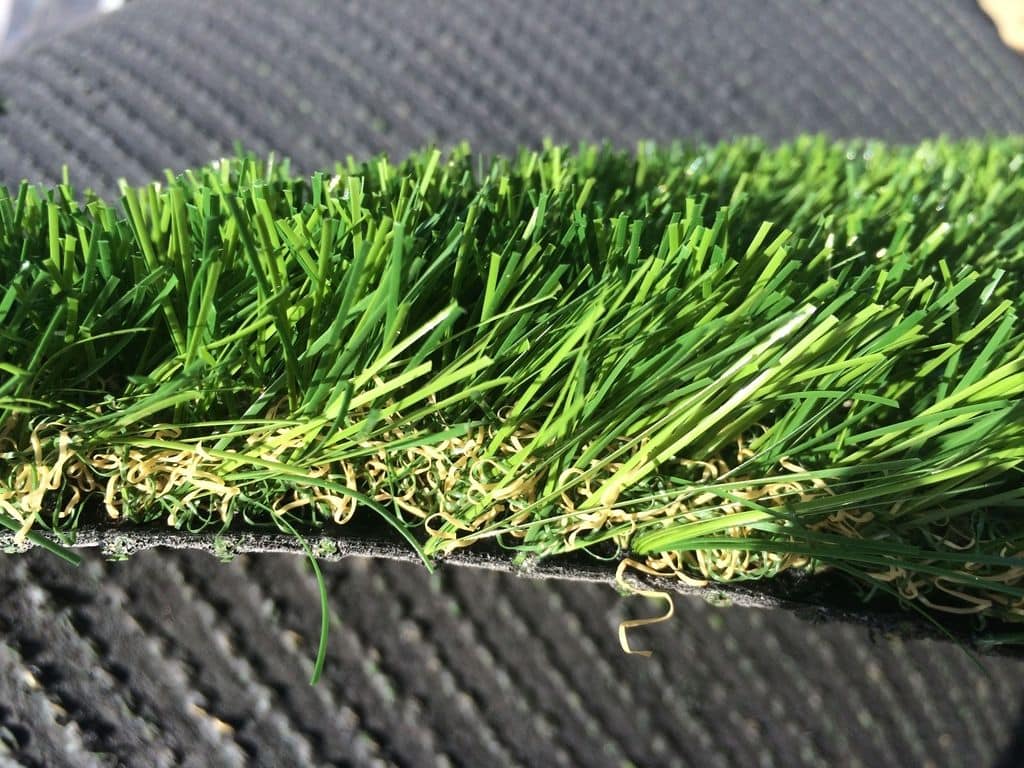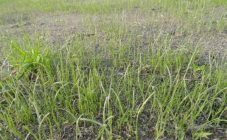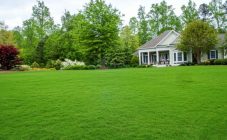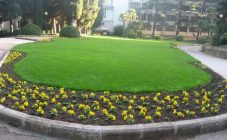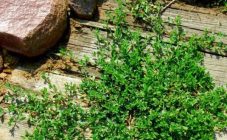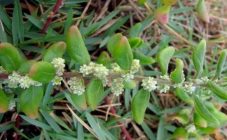Content:
The design of burials most often involves the installation of traditional marble or granite slabs, but in this case, the site looks gloomy and gray. On the other hand, the maintenance of the natural turf on the grave is quite problematic - the cemetery is not often visited, so it is impossible to take care of the site regularly. The best solution in this case is an artificial turf in the cemetery.
About artificial grass for a cemetery: description, materials
Artificial Grass for Cemetery is a synthetic covering made of dense pile fiber that simulates a natural lawn. The height of the pile of artificial turf intended for laying on the grave varies from 0.5 to 10 cm.
There are the following types of synthetic turf:
- Unfilled lawn is the most natural surface in appearance, but the pile is vulnerable to mechanical damage. He quickly tramples, but the fact that the grass is fake can only be seen from very close range. This type of covering is most often chosen as the artificial grass for laying on graves.
- A semi-filled lawn is a synthetic turf, usually made of polyethylene, which explains its elasticity. This coating softens falls, so it is often used to decorate playgrounds. The wear resistance of the lawn surface increases when the fiber is covered with fine quartz sand.
- Backfill lawn is highly resistant to trampling, therefore it is laid in places where heavy loads are possible. Bulk plastic grass for cemeteries is made from polypropylene. After installation, the lawn flooring is sprinkled with quartz sand to make it less slippery.
It is important to consider the local climatic conditions when choosing turf turf. For example, in regions with a cold climate, it is better to put a material made of polyethylene. Such a coating is able to withstand sudden temperature changes and lasts a long time even with frequent mechanical stress.
Laying artificial turf
To lay artificial grass, you do not need to call a specialist - the procedure is quite simple, and if you wish, you can lay the lawn yourself. However, it is important to follow all the rules for fixing the grass to the surface, otherwise the edges of the coating will bend, and excess moisture may accumulate under the lawn.
The process of laying a rolled lawn on open ground is as follows:
- Before fixing the flooring on the site, it is necessary to lay a substrate under it. For this, a lutrasil or ordinary geofilm is suitable. The underlay is essential to prevent weeds from growing under the lawn.
- Grass is rolled out on top of the substrate, and it is important to lay the lawn rolls with an overlap, which will subsequently facilitate the process of joining the rows. Each next roll is superimposed on the previous one with a margin of 2 cm.
- It is recommended to leave the laid lawn alone for several hours - during this time, the covering will straighten, and the villi will take a vertical position.
- The next step is to trim the lawn.The edges of the flooring are trimmed so that the end of one roll fits snugly against the beginning of the other.
- Bonding rolls together. The edges of the canvases are fixed with a connecting tape with two-component adhesive. The optimum width of the tape is 28 cm. The glue is applied with a spatula to the tape in a strip of 25 cm.
- The edges of the rolls are pressed tightly against the connecting tapes, after which the seams are rolled with a roller.
- If the plastic grass is of the filling or semi-filling type, then it is necessary to cover it with quartz sand with a layer of 5 mm.
- The final step is to comb the artificial grass to better compact the sand between the fibers of the lawn.
Also, the grass can be fixed on the site with large nails - this is the easiest way to lay the lawn, but in this case, there is a high probability that the canvas will detach under the influence of strong wind.
Pros of artificial turf
There are the following advantages of a plastic lawn for a cemetery or garden over other types of coverage:
- Artificial lawn flooring is made of durable materials that are resistant to mechanical stress, heavy rainfall, water erosion and sudden temperature changes.
- Modern synthetic cemetery grass does not fade, even when exposed to direct sunlight.
- The structure of the plastic turf minimizes soil damage as it allows air and water to enter the soil well.
- Huge selection of color palette - there is a large assortment of lawn coverings, thanks to which synthetic flooring can be successfully entered into the design of any style site, if you choose the right pile color to match the tone of gravestones and plants.
- Artificial turf is much easier to care for than natural turf - it doesn't need to be watered, pruned or fed. This is especially true when laying a lawn for a grave, since in most cases people do not have the opportunity to travel to the cemetery too often. Caring for plastic flooring comes down to periodic cleaning of debris and loosening the pile.
- Durability - The highest quality artificial grass, when properly laid, can retain its original appearance for up to 15 years. The shelf life of flooring in a lower price category is on average about 5-6 years.
There are no pronounced shortcomings in the synthetic coating, however, due to strong winds, the canvas may shift or deform. However, if the lawn is properly laid, this problem will not arise.
Preparatory work before laying artificial turf
Before fixing the artificial turf in rolls for a cemetery or garden, you must carefully prepare the soil area.
The preparation procedure includes the following steps:
- Step one - cleaning the site, on which the flooring will be laid in the future. To do this, remove all debris and weeds.
- After that, the surface of the lawn area is leveled. At the same time, it is important to create a slight slope, due to which moisture stagnation will not form on the grave.
- Next, the soil is tamped with a roller or by patting it with a board.
- After compacting the soil, it is necessary to form a drainage ditch. Synthetic fiber is not afraid of precipitation, but the soil under it can rot if you do not install a drainage base. Furrows are dug along the edges of the flooring area into which water will flow.
- Before laying the lawn directly, you must wait 8-10 hours so that the soil is completely leveled.
The improvement of burials can be carried out in various ways. The traditional design implies natural landscaping. For many centuries, people have ennobled the graves of relatives and friends, planting flowers, shrubs and small trees on the plots.Today, due to the busyness and remoteness of cemeteries, many prefer methods of decorating burials that do not require a lot of time.
That is why the artificial turf on the grave has become very popular so that the grass does not grow and does not require special care. After all, when laying synthetic flooring, there is no need to remove weeds and regular watering.
